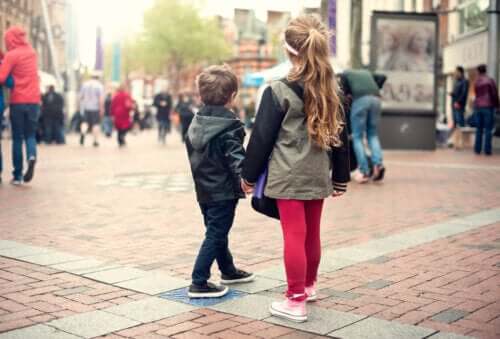Raising Children in a Small Town vs. in the City

Parents always want the best for their children, and there are thousands of questions that arise regarding their upbringing. One of these questions is whether to raise children in a small town or in the city. And, as with many important life decisions, there’s no one right answer to this dichotomy, as both rural life and city life have positive and negative aspects.
What are small towns like and what’s the city like?
When we speak of a small town, we’re referring to a small population with a small number of inhabitants. The activities of a small town generally have to do with the primary sector, that is, to the countryside and rural areas. And, because it’s a small town with few inhabitants, distances are shorter and people can move around more easily on foot or by bicycle.
The city, on the other hand, is an urban space with a high population density, where the inhabitants engage mainly in secondary and tertiary sector activities. For example, industry, commerce, and services. In addition, because it’s a larger conglomerate of people in a larger territory, people must use public transportation or their private vehicles to get around.
Differences between raising your children in a small town or a city
As we said at the beginning, the decision to raise children in a small town or a city is very personal and something that both parents agree upon, depending on the educational objectives they have regarding their children.
In this sense, we want to share succinctly and concretely some of the differences that exist between raising a child in a small town or in the city. That way, we can help you evaluate the pros and cons.

Raising children in a small town…
Closer ties
In smaller towns, people know each other better and, in the case of any problem or need, you’ll always meet people willing to lend a hand. But, at the same time, people have less privacy, even if you try to preserve it. In other words, everyone knows one another and, inevitably, everyone’s more aware of one another’s business.
In addition, being a small population, the inhabitants of the small towns, for the most part, develop a very strong sense of belonging. This is based on the town’s own activities and its popular traditions and customs. This allows the people of the area to have closer and closer ties.
Contact with nature
Small towns are immersed in or close to the countryside. Therefore, people in a village have constant contact with nature and, as a result, more contact with animals and vegetation. What’s more, they have the possibility of doing activities related to agriculture and livestock.
Scarce cultural and educational offerings
Although towns have popular festivals on certain days, they have fewer cultural opportunities than cities. In other words, there are fewer options to see plays, go to the movies, visit museums, or any other type of event related to culture or knowledge. To do so, you need to travel to large cities where these types of events are more available.
At the same time, there are fewer educational options and universities in small towns than there are in big cities. Therefore, children in a small town can be educated at the compulsory levels (elementary and secondary). And they may even have a community college in the area. However, to pursue a university degree, they may need to relocate to a larger city.

In the city
Less contact with people
Cities, the larger they are, are places where contact with people is minimal. Although you’re always surrounded by people, the bonds between you are almost non-existent.
Social relations in the city exist within your closest circle of people – family, friends from school, and other activities. In other words, in big cities, unlike in towns, people have almost no relationship with neighbors or with store or supermarket clerks.
Contact with technology
Unlike in small towns where contact with nature is more possible, in the city, contact with technology predominates. This means that, in the city, people have access to permanent technological development in all areas of daily, professional, and working life.
Countless cultural, leisure, and educational opportunities
Obviously, because of the size of the population and its complexity, leisure and cultural opportunities in cities are numerous. In the city, we have access to movie theaters, bars and restaurants, museums, theaters, fairs, conventions, and events on all kinds of topics. Therefore, children, young people, and adults have a wide range of options to learn and have fun.
At the same time, the city offers parents and their children many alternatives for education and training. There’s a wide range of schools, institutes, universities, and educational centers. Thus, parents have many possibilities to choose where, with whom, and how their children will be educated.

Other differences to consider between raising your children in a small town or in the city
Among the other differences that exist and, therefore, aspects to consider when deciding where to raise your family, is access to the health and medical system. In small towns, there are fewer people and, therefore, fewer medical professionals. This means that there’s less specialization and less complex medical infrastructure in general.
On the other hand, the issue of safety is another aspect to consider. Small towns, unlike cities, tend to be safer places with lower crime rates. Homes are less vulnerable to theft, there’s more tranquility for children to play alone in the street or in the parks, and for them to use public transportation to go to places on their own. Unlike in large cities, where parents must accompany their children to school or to their activities.
Finally, it’s also important to note the difference in the availability of products and services in general that exists in a town or city. In this regard, as with all other aspects, it’s up to the parents to evaluate whether this is a disadvantage or an advantage when deciding to raise children in a town or a city.
Parents always want the best for their children, and there are thousands of questions that arise regarding their upbringing. One of these questions is whether to raise children in a small town or in the city. And, as with many important life decisions, there’s no one right answer to this dichotomy, as both rural life and city life have positive and negative aspects.
What are small towns like and what’s the city like?
When we speak of a small town, we’re referring to a small population with a small number of inhabitants. The activities of a small town generally have to do with the primary sector, that is, to the countryside and rural areas. And, because it’s a small town with few inhabitants, distances are shorter and people can move around more easily on foot or by bicycle.
The city, on the other hand, is an urban space with a high population density, where the inhabitants engage mainly in secondary and tertiary sector activities. For example, industry, commerce, and services. In addition, because it’s a larger conglomerate of people in a larger territory, people must use public transportation or their private vehicles to get around.
Differences between raising your children in a small town or a city
As we said at the beginning, the decision to raise children in a small town or a city is very personal and something that both parents agree upon, depending on the educational objectives they have regarding their children.
In this sense, we want to share succinctly and concretely some of the differences that exist between raising a child in a small town or in the city. That way, we can help you evaluate the pros and cons.

Raising children in a small town…
Closer ties
In smaller towns, people know each other better and, in the case of any problem or need, you’ll always meet people willing to lend a hand. But, at the same time, people have less privacy, even if you try to preserve it. In other words, everyone knows one another and, inevitably, everyone’s more aware of one another’s business.
In addition, being a small population, the inhabitants of the small towns, for the most part, develop a very strong sense of belonging. This is based on the town’s own activities and its popular traditions and customs. This allows the people of the area to have closer and closer ties.
Contact with nature
Small towns are immersed in or close to the countryside. Therefore, people in a village have constant contact with nature and, as a result, more contact with animals and vegetation. What’s more, they have the possibility of doing activities related to agriculture and livestock.
Scarce cultural and educational offerings
Although towns have popular festivals on certain days, they have fewer cultural opportunities than cities. In other words, there are fewer options to see plays, go to the movies, visit museums, or any other type of event related to culture or knowledge. To do so, you need to travel to large cities where these types of events are more available.
At the same time, there are fewer educational options and universities in small towns than there are in big cities. Therefore, children in a small town can be educated at the compulsory levels (elementary and secondary). And they may even have a community college in the area. However, to pursue a university degree, they may need to relocate to a larger city.

In the city
Less contact with people
Cities, the larger they are, are places where contact with people is minimal. Although you’re always surrounded by people, the bonds between you are almost non-existent.
Social relations in the city exist within your closest circle of people – family, friends from school, and other activities. In other words, in big cities, unlike in towns, people have almost no relationship with neighbors or with store or supermarket clerks.
Contact with technology
Unlike in small towns where contact with nature is more possible, in the city, contact with technology predominates. This means that, in the city, people have access to permanent technological development in all areas of daily, professional, and working life.
Countless cultural, leisure, and educational opportunities
Obviously, because of the size of the population and its complexity, leisure and cultural opportunities in cities are numerous. In the city, we have access to movie theaters, bars and restaurants, museums, theaters, fairs, conventions, and events on all kinds of topics. Therefore, children, young people, and adults have a wide range of options to learn and have fun.
At the same time, the city offers parents and their children many alternatives for education and training. There’s a wide range of schools, institutes, universities, and educational centers. Thus, parents have many possibilities to choose where, with whom, and how their children will be educated.

Other differences to consider between raising your children in a small town or in the city
Among the other differences that exist and, therefore, aspects to consider when deciding where to raise your family, is access to the health and medical system. In small towns, there are fewer people and, therefore, fewer medical professionals. This means that there’s less specialization and less complex medical infrastructure in general.
On the other hand, the issue of safety is another aspect to consider. Small towns, unlike cities, tend to be safer places with lower crime rates. Homes are less vulnerable to theft, there’s more tranquility for children to play alone in the street or in the parks, and for them to use public transportation to go to places on their own. Unlike in large cities, where parents must accompany their children to school or to their activities.
Finally, it’s also important to note the difference in the availability of products and services in general that exists in a town or city. In this regard, as with all other aspects, it’s up to the parents to evaluate whether this is a disadvantage or an advantage when deciding to raise children in a town or a city.
All cited sources were thoroughly reviewed by our team to ensure their quality, reliability, currency, and validity. The bibliography of this article was considered reliable and of academic or scientific accuracy.
- Luna, R. S. (2018). La inspección ante la brecha educativa rural-urbano en España. Avances en Supervisión Educativa, (30). Recuperado de https://avances.adide.org/index.php/ase/article/view/634
- Camarero, L., Cruz, F., González, M., del Pino, J. A., Oliva, J. y Sampedro, R. (2009). La población rural de España. Colección Estudios Sociales, 27. Recuperado de https://s3.amazonaws.com/academia.edu.documents/32785200/La_poblacion_rural_de_Espana27_es.pdf?response-content-disposition=inline%3B%20filename%3DLa_poblacion_rural_de_Espana_de_los_dese.pdf&X-Amz-Algorithm=AWS4-HMAC-SHA256&X-Amz-Credential=AKIAIWOWYYGZ2Y53UL3A%2F20200206%2Fus-east-1%2Fs3%2Faws4_request&X-Amz-Date=20200206T112414Z&X-Amz-Expires=3600&X-Amz-SignedHeaders=host&X-Amz-Signature=d6693cbc860541f6360ad70eebca3da84666c4eeab0734993721f18833e23260
- Goerlich, F. J. y Mas, M. (2008). Sobre el tamaño de las ciudades en España. Dos reflexiones y una regularidad empírica. Recuperado de https://mpra.ub.uni-muenchen.de/15798/1/MPRA_paper_15798.pdf
This text is provided for informational purposes only and does not replace consultation with a professional. If in doubt, consult your specialist.








